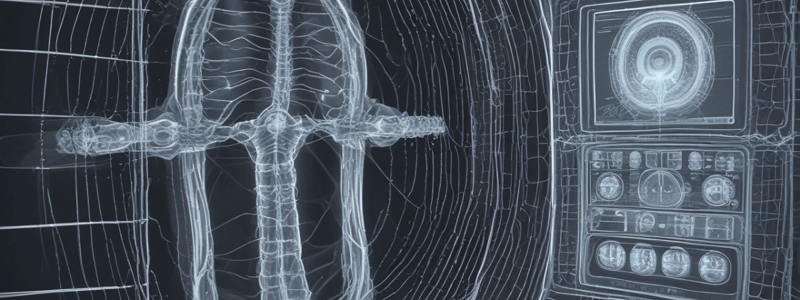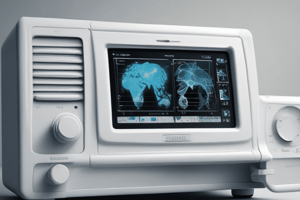Podcast
Questions and Answers
What event spurred the advancement of SONAR technology?
What event spurred the advancement of SONAR technology?
- The Cold War
- World War I (correct)
- The American Civil War
- World War II
Who identified the piezoelectric effect?
Who identified the piezoelectric effect?
- The Dussik brothers
- The Curie brothers (correct)
- Dr. Ibrahim Hadadi
- Langevin and Spallanzani
What was the significance of the 1940s in ultrasound technology?
What was the significance of the 1940s in ultrasound technology?
- The introduction of 'B Mode' imaging
- The development of 3D ultrasound imaging
- The start of diagnostic uses for ultrasound (correct)
- The invention of SONAR technology
Who published the pioneering study on ultrasound examination of the brain?
Who published the pioneering study on ultrasound examination of the brain?
What is the significance of the year 1794 in ultrasound technology?
What is the significance of the year 1794 in ultrasound technology?
Who created an early ultrasound device using piezoelectric principles?
Who created an early ultrasound device using piezoelectric principles?
What is the name of the imaging mode developed from pulsed ultrasound technology?
What is the name of the imaging mode developed from pulsed ultrasound technology?
What was the significance of the 1930s in ultrasound technology?
What was the significance of the 1930s in ultrasound technology?
What is the significance of the year 1917 in ultrasound technology?
What is the significance of the year 1917 in ultrasound technology?
What is the significance of the year 1912 in ultrasound technology?
What is the significance of the year 1912 in ultrasound technology?
Where did the clinical adoption of ultrasound commence in 1956?
Where did the clinical adoption of ultrasound commence in 1956?
What type of waves are mechanical waves classified as?
What type of waves are mechanical waves classified as?
What is required for sound waves to propagate?
What is required for sound waves to propagate?
What is the term for an increase in pressure or density in a sound wave?
What is the term for an increase in pressure or density in a sound wave?
What occurs during the troughs of a sound wave?
What occurs during the troughs of a sound wave?
What is the term for a disturbance or fluctuation that transfers energy from one location to another?
What is the term for a disturbance or fluctuation that transfers energy from one location to another?
What is the term for the particles that make up matter, interconnected through elastic intermolecular forces?
What is the term for the particles that make up matter, interconnected through elastic intermolecular forces?
What is the result of a vibration occurring in a medium?
What is the result of a vibration occurring in a medium?
Who pioneered the use of B-mode ultrasound for brachial plexus blockade procedures?
Who pioneered the use of B-mode ultrasound for brachial plexus blockade procedures?
What is the term for the movement of energy from one location to another?
What is the term for the movement of energy from one location to another?
What is the main characteristic of mechanical waves?
What is the main characteristic of mechanical waves?
Which type of wave does not require a medium and can propagate through a vacuum?
Which type of wave does not require a medium and can propagate through a vacuum?
What is the direction of particle displacement in longitudinal waves?
What is the direction of particle displacement in longitudinal waves?
What is the speed of electromagnetic waves in a vacuum?
What is the speed of electromagnetic waves in a vacuum?
What is the relationship between two parameters if an increase in one results in a decrease in the other?
What is the relationship between two parameters if an increase in one results in a decrease in the other?
What are the key parameters of sound waves?
What are the key parameters of sound waves?
What is the frequency of a sound wave?
What is the frequency of a sound wave?
What is an example of a mechanical wave?
What is an example of a mechanical wave?
What is the direction of particle displacement in transverse waves?
What is the direction of particle displacement in transverse waves?
What is the characteristic of longitudinal waves?
What is the characteristic of longitudinal waves?
What is the unit of measurement for frequency in sound waves?
What is the unit of measurement for frequency in sound waves?
What determines the frequency of a sound wave?
What determines the frequency of a sound wave?
What is the product of frequency and period in sound waves?
What is the product of frequency and period in sound waves?
What is the frequency of a sound wave that has five cycles in one millionth of a second?
What is the frequency of a sound wave that has five cycles in one millionth of a second?
What determines the resonance frequency of an ultrasound transducer?
What determines the resonance frequency of an ultrasound transducer?
What is the role of frequency in sonographic images?
What is the role of frequency in sonographic images?
How is frequency adjustable in ultrasound technology?
How is frequency adjustable in ultrasound technology?
What is the range of typical frequency values in medical ultrasound?
What is the range of typical frequency values in medical ultrasound?
What is the effect of thicker crystals in an ultrasound transducer?
What is the effect of thicker crystals in an ultrasound transducer?
What is the definition of frequency in sound waves?
What is the definition of frequency in sound waves?
Study Notes
The Evolution of Ultrasound Technology
- The evolution of ultrasound technology began with World War I's naval warfare, which spurred the advancement of SONAR technology for military purposes.
- In 1794, Spallanzani explored the discovery of sound beyond the audible spectrum.
- The Curie brothers, Pierre and Jacques, identified the piezoelectric effect in 1880, which is foundational for later ultrasound technology.
- In 1912, Langevin created an early ultrasound device using piezoelectric principles.
- Diagnostic uses for ultrasound started to emerge in the 1930s, marking a new era in medical imaging.
- Institutions worldwide developed pulsed ultrasound technology in the 1950s, leading to 'B Mode' imaging.
- The real-time B-scan ultrasound was developed and introduced in obstetric imaging in the 1980s.
- Ultrasound technology expanded with the advent of three-dimensional (3D) and four-dimensional (4D) imaging in the 1990s.
What is Sound?
- Sound is an energy form generated through vibration, transmitting energy from one location to another through a mechanical or longitudinal wave.
- Sound waves require a medium (solid, liquid, or gas) and are characterized by alternating compressions and rarefactions.
- Compressions signify an increase in pressure or density, while rarefactions occur during the troughs of the sound wave, where the vibrating source of the sound wave moves away from the molecules, causing them to become less densely packed.
Wave Formation and Classification
- A wave is a disturbance or fluctuation that transfers energy from one location to another within a medium.
- Mechanical waves are longitudinal waves, where the displacement of the medium is in the same direction as the direction of the wave's propagation.
- Examples of mechanical waves include ocean waves, sound waves, and seismic waves.
- Electromagnetic waves (transverse wave) do not require a medium and can propagate through a vacuum, including examples such as radio waves, X-rays, and light.
Longitudinal vs. Transverse Wave
- Longitudinal waves: particle displacement occurs parallel to the wave's direction of energy movement.
- Transverse waves: particle displacement occurs perpendicular to the wave's direction of propagation.
Understanding Parameters in Acoustics
- Parameters can exhibit direct or inverse proportional relationships.
- Key parameters of sound waves include frequency, period, wavelength, propagation speed, amplitude, power, and intensity.
Sound Wave Parameters: Frequency
- Frequency (f) measures the occurrence rate of an event, referring to the number of complete cycles of pressure variation in one second.
- Units of frequency are measured in hertz (Hz), kilohertz (kHz), and megahertz (MHz).
- Typical frequency values in medical ultrasound range from 2 to 15 MHz.
- Frequency is determined by the sound source, and the product of frequency and period equals 1 second.
Resonance Frequency in Ultrasound Transducers
- The resonance frequency of an ultrasound transducer is primarily determined by its piezoelectric crystals.
- Thinner crystals in the transducer vibrate at higher frequencies compared to thicker crystals.
- Frequency plays a crucial role in determining the resolution and penetration of sonographic images.
Studying That Suits You
Use AI to generate personalized quizzes and flashcards to suit your learning preferences.
Related Documents
Description
This quiz covers the evolution of ultrasound technology, from its roots in World War I naval warfare to its current applications in the medical industry. Learn about the pioneers who contributed to its development.




